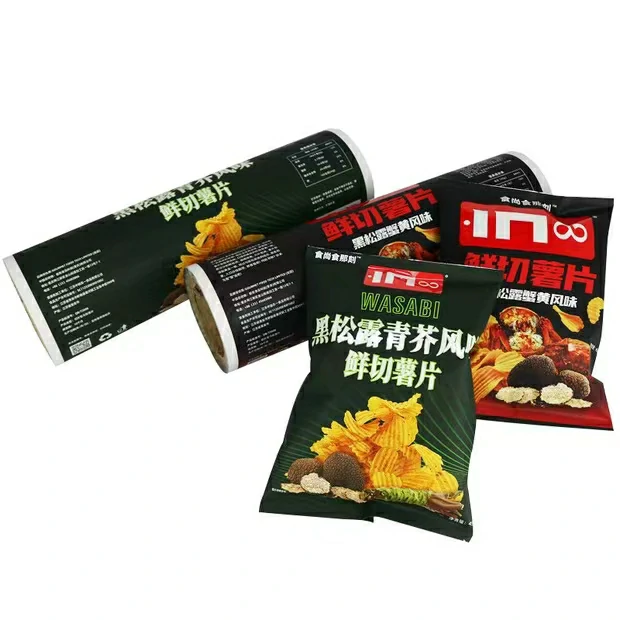Food packaging plastic bags are designed to ensure product integrity during storage and transit through various features and properties:
- Barrier Properties: Plastic bags can be manufactured with specific barrier properties to protect food products from external factors such as moisture, oxygen, light, and odors. Barrier films or coatings prevent moisture loss or ingress, oxygen exposure, and contamination, thereby maintaining the freshness and quality of the food.
- Sealing Mechanisms: Plastic bags often feature secure sealing mechanisms such as heat sealing, zip-lock closures, or adhesive closures. These sealing mechanisms create a tight seal that prevents leakage, spillage, and contamination during storage and transportation.
- Puncture Resistance: High-quality plastic bags are engineered to be puncture-resistant, reducing the risk of damage to the packaging and the food product inside during handling, stacking, or transit.
- Tamper-Evident Features: Some plastic bags are equipped with tamper-evident features such as tear strips or tamper-evident seals. These features provide visual indication if the packaging has been opened or tampered with, ensuring product safety and integrity.
- UV Protection: Plastic bags can be formulated with UV inhibitors to protect light-sensitive food products from degradation caused by exposure to ultraviolet (UV) light. UV protection helps maintain the color, flavor, and nutritional value of the food.
- Customized Sizing and Shapes: Plastic bags can be customized in terms of size, shape, and thickness to fit the specific requirements of different food products. Proper sizing and shaping minimize excess air inside the packaging, food packaging plastic bags reducing the risk of product spoilage and extending shelf life.
- Resealability: Many plastic bags are resealable, allowing consumers to open and close the packaging multiple times while maintaining product freshness. Resealable features also prevent spills and ensure convenient storage of partially consumed food items.
- Printed Information: Food packaging plastic bags often include printed information such as product details, expiration dates, storage instructions, and safety warnings. Clear and informative labeling helps consumers make informed decisions and ensures proper handling of the food product.
- Compliance with Regulations: Plastic bags used for food packaging must comply with regulatory standards and food safety regulations. Manufacturers ensure that their plastic bags are made from food-grade materials and meet the requirements for safe storage and transportation of food products.
- Quality Control Measures: During manufacturing, plastic bags undergo stringent quality control measures to ensure consistency, durability, and reliability. Quality assurance processes include testing for seal integrity, barrier properties, and overall structural strength to guarantee product integrity during storage and transit.
By incorporating these features and properties, food packaging plastic bags effectively safeguard the integrity of food products during storage and transit, preserving freshness, quality, and safety from production to consumption.
What are the considerations for choosing the right food grade bags for food packaging for a specific product?
When choosing food grade bags for food packaging for a specific product, several considerations should be taken into account to ensure that the packaging meets the unique requirements of the product and maintains its integrity throughout storage, transportation, and consumption. Some key considerations include:
- Type of Food Product: Consider the type of food product being packaged, including its physical characteristics (solid, liquid, powder), moisture content, acidity level, and susceptibility to spoilage. Different types of food may require different packaging materials and formats to ensure optimal preservation and safety.
- Packaging Material: Select packaging materials that are suitable for direct contact with food and comply with regulatory standards for food safety. Common food-grade packaging materials include polyethylene (PE), polypropylene (PP), polyethylene terephthalate (PET), and aluminum foil. Each material has specific properties that may be more suitable for certain types of food products.
- Barrier Properties: Assess the required barrier properties of the packaging material to protect the food product from external factors such as moisture, oxygen, light, and odors. Consider factors such as the shelf life of the product, the need for UV protection, and the sensitivity of the food to environmental conditions.
- Sealing Mechanism: Choose the appropriate sealing mechanism based on the packaging format and the intended use of the product. Options include heat sealing, zip-lock closures, adhesive closures, and tamper-evident seals. The sealing mechanism should provide a secure and airtight seal to prevent leakage and contamination.
- Packaging Format: Consider the most suitable packaging format for the specific food product, such as pouches, bags, trays, sachets, or containers. The packaging format should accommodate the shape, size, and quantity of the product while ensuring efficient handling, storage, and display.
- Labeling Requirements: Determine the necessary labeling requirements for the food product, including product information, nutritional facts, food grade bags for food packaging expiration date, allergen warnings, and barcode labeling. Ensure that the packaging material allows for clear and legible labeling that complies with regulatory standards.
- Packaging Size and Shape: Choose the appropriate size and shape of the food grade bags to optimize product-to-package ratio, minimize excess air inside the packaging, and maximize shelf space utilization. Consider factors such as portion size, serving suggestions, and consumer convenience.
- Environmental Considerations: Evaluate the environmental impact of the packaging material and choose options that align with sustainability goals. Look for recyclable, compostable, or biodegradable packaging materials that minimize environmental footprint and support circular economy initiatives.
- Transportation and Storage Conditions: Consider the conditions during transportation and storage, such as temperature fluctuations, humidity levels, and exposure to light. Choose packaging materials that can withstand these conditions and protect the food product from degradation or spoilage.
- Cost and Budget: Assess the cost-effectiveness of the packaging solution in relation to the budget constraints and the expected return on investment. Balance the quality, functionality, and aesthetics of the packaging with the overall cost to ensure a competitive offering in the market.
By carefully considering these factors, food manufacturers and retailers can choose the right food grade bags for food packaging that meet the specific requirements of their products, ensure food safety and quality, and enhance consumer satisfaction.
